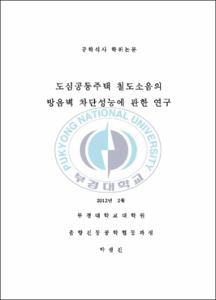도심공동주택 철도소음의 방음벽 차단성능에 관한 연구
- Abstract
- Abstract
In this study, the noise of railway of Donghae Nambu line was examined as it is expected that the residential environment of apartment house, located at the field of railway side of B-si, H-gu, will be affected.
To investigate the sound-insulation performance of the existing 5 m high-coloured soundproof wall, models of different height in soundproof wall were chosen and computer simulation with Cadna-A program was used to predict sound level for each floor of the selected apartment house.
Through the comparison of expected noise of models before its installation and by height, the performance of each model for soundproofing was investigated and sound level of each floor after the installation of the 5 m-high soundproof wall was measured. Expected noise and measured one were compared.
The results are as follows.
1. Under the simulation of existing soundproof wall being installed on the site and considering insertion loss of the wall, the setting of 5 m high wall turned out appropriate for soundproofing for lower floors(3~8F) having short distance length of the apartment house, while the higher floors of the apartment house were barely influenced by the noise of railway for both day and night, because they have distance length enough to block the noise.
2. When an 8m~12m high soundproofing wall was set up, the noise reduction of floors below 8th floor of the house was higher than the installation of the existing 5m high soundproof wall, but the performance of soundproof wall was limited to the lower floors, therefore, it could be concluded that the existing 5m high soundproofing wall would be efficiently used for the lower floors, when considering noise reduction efficiency. If soundproofing wall is installed at the higher ones than 8th floor, it will inevitably increase construction costs.
3. The comparison of sound level predicted by computer simulation and sound level actually measured shows the difference of 4.5~6.9 dB in the higher floors means that they might get more influenced from background noise than in lower floors, and which was in part due to the completion of the building and development of its surroundings.
4. The evaluation of noise from this research proved to satisfy the noise standard of railway, but it is also judged that maximum noise felt by residents of the apartment house and a boundary by PEAK value cannot be ignored. In addition to such experiment, based on existing standard, reasonable evaluation of noise requires continuously abundant simulation documents, traffic investigation in depth, noise environment investigation linked to railway-induced vibration, noise map and survey on dissatisfaction from residents.
- Issued Date
- 2012
- Awarded Date
- 2012. 2
- Type
- Dissertation
- Publisher
- 부경대학교
- Department
- 대학원 음향진동공학과(협)
- Advisor
- 배동명
- Table Of Contents
- 목 차
1. 서론
1.1 연구의 배경 및 목적
1.2 연구의 내용 및 방법
2. 이론적 고찰
2.1 방음벽
2.1.1 일반사항
2.1.2 방음벽의 높이 산정
2.1.3 방음벽의 길이 산정
2.2 시뮬레이션 사용 프로그램
2.3 소음 예측에 적용한 소음 예측식
2.4 교통 소음에 관한 기준
3. 대상부지 선정 및 소음원 조사
3.1 대상부지 조사
3.1.1 주변환경
3.1.2 소음발생원 현황
3.1.3 철도교통 현황
3.2 대상 소음원 조사
3.2.1 측정방법
3.2.2 측정장비
3.2.3 지점별 측정결과
4. 방음벽 차단성능 예측
4.1 대상소음도 예측
4.2 방음벽 높이에 따른 모델 선정
4.3 시뮬레이션에 의한 저감량 예측
4.4 시뮬레이션 결과
4.4.1 모델-1(방음벽 설치 전)
4.4.2 모델-2(방음벽 높이 3 m)
4.4.3 모델-3(방음벽 높이 5 m/기존 설계)
4.4.4 모델-4(방음벽 높이 8 m)
4.4.5 모델-5(방음벽 높이 12 m)
4.4.6 모델에 따른 각 층의 예측소음도 및 저감량
5. 방음벽 설계 타당성 검토
5.1 방음벽 설치 후 소음도 측정
5.2 예측소음도 및 측정소음도 비교
6. 결 론
참고문헌
부 록
- Degree
- Master
- Appears in Collections:
- 과학기술융합전문대학원 > 기타 학과
- Files in This Item:
-
-
Download
 도심공동주택 철도소음의 방음벽 차단성능에 관한 연구.pdf
기타 데이터 / 2.91 MB / Adobe PDF
도심공동주택 철도소음의 방음벽 차단성능에 관한 연구.pdf
기타 데이터 / 2.91 MB / Adobe PDF
-
Items in Repository are protected by copyright, with all rights reserved, unless otherwise indicated.